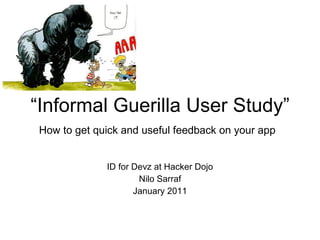Informal Guerilla User Study
- 1. “ Informal Guerilla User Study” How to get quick and useful feedback on your app ID for Devz at Hacker Dojo Nilo Sarraf January 2011
- 2. We see what we want to see!
- 3. Assumptions In research do NOT assume! Researcher bias: “I know the results before I even go into the lab!” Even top researchers are biased Humans are complex machines
- 4. Get Divorced! Divorce your app Be objective Get stupid when doing research on your app!
- 5. Know Thy User Even when they look totally alien to you Body language/body gestures Tone of voice Personality types Context/Environment Mood swings
- 6. The Observer Effect Physics Changes that the act of observation will make on the phenomenon being observed Information Technology The potential impact of the act of observing a process output while the process is running Psychology A form of reactivity, in which a researcher's cognitive bias causes them to subconsciously influence the participants of an experiment
- 7. How to Observe Users Observational techniques Behavioral Facial muscles Body gestures Voice pitch Choice of words
- 8. ?
- 9. Source: Elsevier 2010 http://comminfo.rutgers.edu/~tefko/Courses/Zadar/Doctoral%20studies/Lopatovska%20emotions%20in%20LIS%20IPM%202011%20artcle%20in%20press.pdf
- 10. Voice and Choice of Words “Know Thy User” High or low pitch Energetic or tired Fast or slow Pauses between words Choice of words
- 11. Personality Types (Psychology) Openness to Experience : the tendency to be imaginative, independent, and interested in variety vs. practical, conforming, and interested in routine Conscientiousness : the tendency to be organized, careful, and disciplined vs. disorganized, careless, and impulsive Extraversion : the tendency to be sociable, fun-loving, and affectionate vs. retiring, somber, and reserved Agreeableness : the tendency to be softhearted, trusting, and helpful vs. ruthless, suspicious, and uncooperative Neuroticism : the tendency to be calm, secure, and self-satisfied vs. anxious, insecure, and self-pitying
- 12. Personality Types “Know Thy User” Type "A” Is a highly independent and driven personality, typically representing the leaders in business Type "B" Represents highly extroverted people who love the spotlight Type "C" The antithesis of Type "B"; they are introverted detailists as represented by such people as accountants, programmers, and engineers Type "D" Personality Is best characterized as those people who resist any form of change and prefer the tedium of routine, such as in clerical assignments
- 13. Type A Independent Go-getters Aggressive Driven personality Leaders in business
- 14. Type B Highly extroverted Gregarious Love the spotlight Attractive
- 15. Type C The antithesis of Type "B” Don’t like the spot light Introverted detailists Accountants, Programmers Engineers
- 16. Type D Resist any form of change Prefer the tedium of routine Clerical assignments
- 17. ?
- 18. Environment “Know Thy User” Familiar or unfamiliar location At the Café next door or at a usability lab Do you know the user personally?
- 19. Mood Swings “Know Thy User” Weather Sunny or rainy Time of the day Morning or evening Time of the week Monday or Friday
- 20. Let’s Get Practical Informal User Study aka Guerilla testing, Dry run, and Hallway testing A quick and easy test Should take no more than 15 min
- 21. Before User Study Roughly speaking… What is your objective? What do you want to find out? Who is your target audience? Do you have paper or full-fledge prototype?
- 22. During User Study It’s not you. It’s me! We are not testing the users but the app We are here to create a better app. So, we need you! Reassuring the user Make them feel ‘at ease’ ‘ At ease’ does not mean comfortable but just relaxed enough to give good insights
- 23. During User Study Listen - needs self-training Observe - needs self-training Have users talk aloud Do NOT prompt users Do NOT ask for design advise Have fixed questions/objectives that you want to find answers to
- 24. Take Notes Tape recording Take notes
- 25. Your Own Body Language Users can tell if you are very attached to your app Be curious Show: I’m here to learn from you! Friendly ‘poker face’ Show openness
- 26. ‘Safe’ Questions “ What do you think/believe this button means/does?” “ Is this what you expected to see?” “ If you were to click on this tab, what would you expect to happen? What would you expect to see?” “ What do you think the app is trying to do/accomplish?” “ Who do you think may find this app useful/beneficial/interesting/handy…?” “ What is your overall feeling/understanding of this app?” “ Where do you think this app would be used?” “ At this point, what would you do?”
- 27. ‘Safe’ Questions “ Taking a quick look, what do you think this app is about? What do you think it does?” “ What would be the first you’d do?” “ Where would you go about exploring?” “ What peeks your interest at this point?” “ What is your overall feeling/understanding of this app?” “ Any final comments you’d like to add?”
- 28. Pause Don’t be afraid to interrupt the user Sometimes users go fast and all over the place Stop the user So, let’s pause for a moment here What are you thinking? How are you deciding your next steps? What are you seeing?
- 29. After User Study Talk about your findings with People in your industry People in other industries Researchers, if you know any Draw possible conclusions Work on your app Decide if you need any follow-up refined studies
- 30. One Last Thing User study is NOT about testing a hypothesis User study is about uncovering new things that you did not know before
- 31. ?































